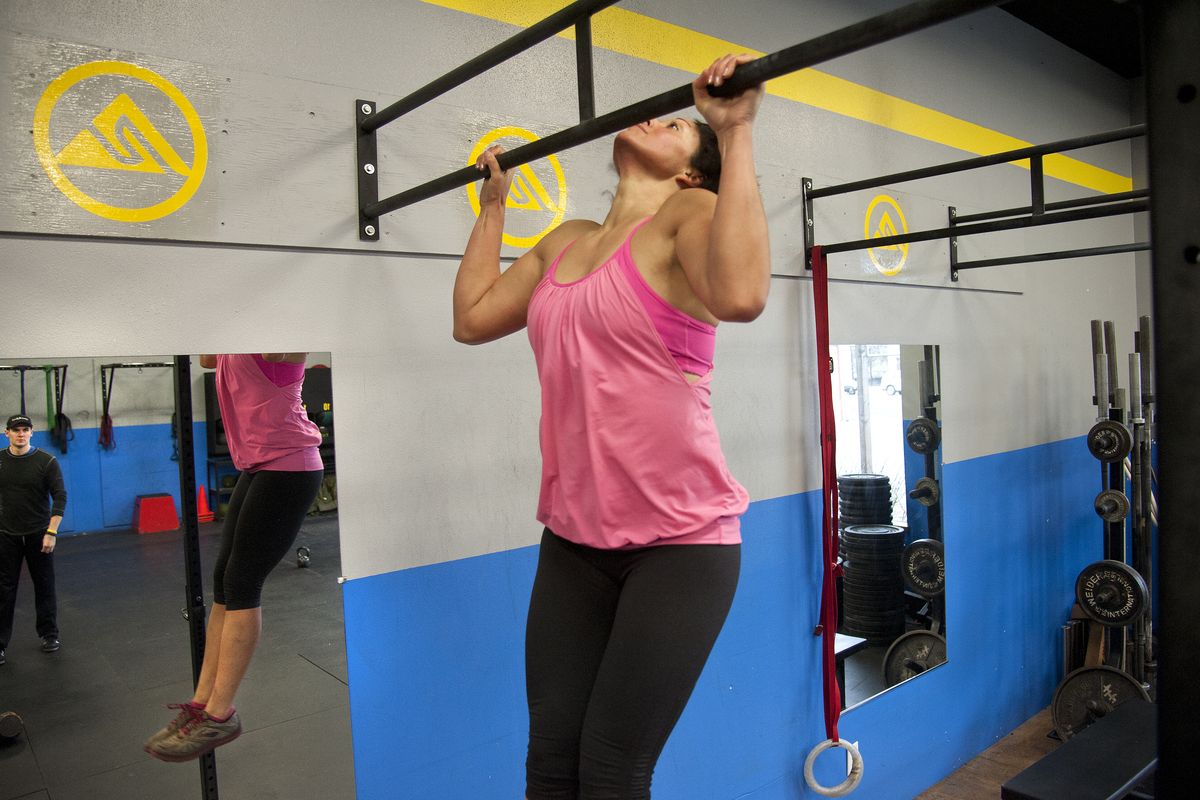CrossFit provides high-intensity, varied workout

When Vanessa Branstetter, 38, started CrossFit last year she couldn’t perform one pull-up. Not only has she conquered that challenge, she’s doing a host of everyday and athletic activities with greater ease, thanks to the workout regimen.
An ER doctor and mother of two, Branstetter said she’d exercised her whole life, from high school sports, kayaking and backpacking to aerobics, yoga and triathlons. But after developing repetitive use injuries from running, including Achilles tendonitis and back pain, she tried CrossFit.
“It’s made me much stronger than I’ve ever been. Anything that involves lifting and carrying things I have more strength and endurance,” she said.
Functionality, variety, intensity
CrossFit is a fitness approach founded in 2000 by Greg Glassman and has quickly become a global sensation, with more than 5,500 gyms globally and 14 in the Inland Northwest, according to the company website. As a workout, it focuses on functional movement that’s constantly varied and performed at high intensity.
Simply, this means you work hard and fast to move your body and other objects, which makes you fitter and stronger. Every workout is different while incorporating elements of gymnastics, weight training and cardiovascular conditioning.
Participants may squat, lift, push, pull, climb, throw or run, often using equipment such as tires, barbells, medicine balls, ropes, sleds or resistance bands.
Compared to a typical gym workout, area coaches said CrossFit engages multiple muscles and joints by mimicking natural movement, rather than relying on isolated muscle repetitions.
“Where in nature do you isolate muscles?” asked Dan Staton, owner of CrossFit Spokane Valley. “Nature doesn’t discriminate. We do compound movements found in nature and put it to use. It’s real fitness you can use outside these four walls.”
A workout for everyone
Mike Gerry, owner of CrossFit Spokane, says it’s for anyone.
“The vast majority are everyday people. We have grandmothers, professional athletes, post surgery, post rehab. Almost any walk of life,” he said. “There is one workout but we modify it for weight, time and range of motion based on where that individual is.”
Learning it could be modified is what converted Staton from a skeptic to a coach.
“I was a critic,” he admitted. Gerry has a master’s degree in exercise physiology and has worked in the fitness industry for 14 years. “I thought the general population had no business doing this level of intensity. I didn’t realize it was 100 percent scale-able.”
“The workouts don’t differ by kind. They differ by degree,” he explained. “The needs of grandparents are different than a Navy Seal. But you still need to be able to move whether you’re protecting freedom or living without the care of a retirement home.”
For Kelly Mehrens, 55, this means she can work out with friends half her age.
“As a middle aged woman it’s important to build strength and core … I can pick up a 30 pound bag of dog food. I can work in my yard, dig, carry plants and pots. I have stamina and strength to do every day things,” she said, adding, “It’s really good emotionally. CrossFit has made me realize I can do stuff I didn’t think I could do.”
The workout approach also appeals to competitive athletes. Kevin Steel opened CrossFit 509 on the North Side after migrating from competitive jiu-jitsu. After losing a match against a former grappling partner, Steel asked about his training. “He beat me badly, which he shouldn’t have. He’d started doing CrossFit.”
For athletes, Steel said, CrossFit is an excellent training tool whether you’re a runner, baseball player or skier, because it follows a fitness hierarchy.
Good diet forms the foundation, followed by cardiovascular conditioning. Proper body control and movement build on that, which is necessary to then correctly lift, throw and move with speed and strength. Competitive sports come last.
If any foundational element is weak it affects athletic performance.
“We build up their weaknesses so they can perform better at their sport,” said Steel. “You’ll be trained to move better, more efficiently, more correctly. It leaves no holes.”
According to Branstetter, CrossFit eliminated her Achilles tendonitis.
“Every workout is varied and involving all your muscles groups, so no one tendon is constantly being stressed. All those overuse injuries have gone away,” she said.
Just as CrossFit workouts are varied, so are the gyms. While CrossFit has many guidelines and resources, it has few requirements.
To become a CrossFit affiliate, a gym owner must submit an essay application, obtain a Level 1 certification that can be accomplished over a weekend and pay a $3,000 annual licensing fee.
As a result, there can be quality differences between affiliate gyms.
“You’ll have good gyms and coaches and not so good gyms and coaches,” Gerry said. “You can go to 10 gyms and have 10 different experiences. My goal as the owner is to have people feel better than when they came in.”
Improving health and community
Unlike exercise programs that focus on weight loss, area coaches said CrossFit aims to improve health and physical ability while building community.
“We chase performance. It’s about moving better as opposed to looking better,” Gerry said. “We want people, when they take the stairs at work or shovel their driveway, say ‘now I’m killing it.’ The people that stick with it make it life changing.”
Area participants said it’s also a lot of fun.
For Mark Didier, a physician at Rockwood Clinic and longtime exerciser, CrossFit was the most intense workout he’d ever experienced when he became hooked four years ago.
“You find yourself pushing yourself more than you would otherwise. That makes it fun,” he said, adding he enjoys the variety. “It’s always a little bit different. You never know what you are going to be doing. Some of the workouts you end up loving to hate. I love the camaraderie with a group of like-minded people.”